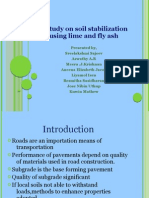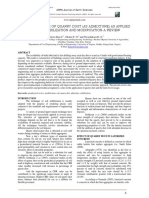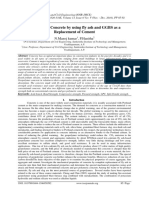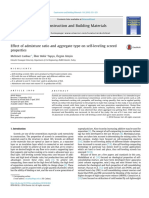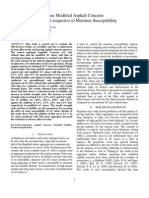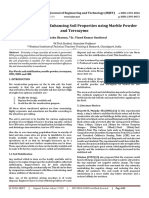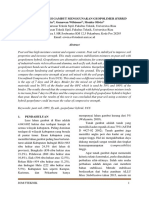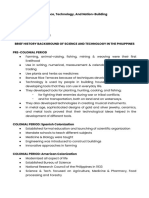Resin As A Soil Stabilizer - Formatted Paper
Resin As A Soil Stabilizer - Formatted Paper
Uploaded by
Abass AbdiCopyright:
Available Formats
Resin As A Soil Stabilizer - Formatted Paper
Resin As A Soil Stabilizer - Formatted Paper
Uploaded by
Abass AbdiOriginal Title
Copyright
Available Formats
Share this document
Did you find this document useful?
Is this content inappropriate?
Copyright:
Available Formats
Resin As A Soil Stabilizer - Formatted Paper
Resin As A Soil Stabilizer - Formatted Paper
Uploaded by
Abass AbdiCopyright:
Available Formats
Journal of Sustainable Construction Engineering and Project Management
Volume 4 Issue 1
Resin as a Soil Stabilizer - A Review
Dr K Balan1, Ananya G2, Dhanya Krishnan R.3*
1
Vice Principle & Dean, 2,3M.Tech Student,
Department of Civil Engineering, Rajadhani Institute of Engineering and Technology,
Nagaroor, Trivandrum, India.
*Corresponding Author
E-mail Id:- dhanyakrdhanya@gmail.com
ABSTRACT
Soil is the most important construction material which is the support of any structure, no
matter what is the function the structure plays. But the problem is that the soil may be a little
tricky and the properties may not be suitable for construction. To make the soil suitable for
use, should be replaced or treated mechanically or chemically. Better to do treating than
replacing. Most suitable among the treatment is use of additives for better bonding. Among
the additives most suitable are polymers such as resins. There are many studies carried to
find the effect of adding various resins on various types of soils. Most of the studies shows
good improvement of soil properties. i.e., resin can be used as better stabilizing agent.
Keywords:- Resin, polymer, soil stabilization
INTRODUCTION When polymers are added to soil, they
The main problem the construction form a thin film around soil particles and
industry faces today is the scarcity of make a better bond between particles. This
suitable resources for construction. Both has an effect on soil properties such as
the land and materials available may be of density and stiffness, moisture retention
poor quality for the specific use. The capability, permeability, strength,
engineering properties of the available consistency limits and swelling.
resources may be modified as per the
demands. Improving the properties of soil Resin is a natural polymer of organic
to carry the imposed load is called Ground chemicals. Some of the examples are
Improvement Technique. The stabilization vinsol resin, rosin, stabinol, resins from
techniques started using from ancient tropical plants etc. There are some
times about thousands of years ago. synthetics resins such as bisphenol A.
Romans and Greeks used lime as stabilizer They are commonly used for production of
for earthen roads. There are many varnishes, food glazing agents; more than
methods such as addition of additives, that resins are good adhesives. Oldest use
providing drains, using vibration etc. Some of resin is in mid-stone age as glue for
commonly used additives are lime, hafting stone tool. The study of using resin
cement, bitumen, which result in as an engineering material started from
increasing the strength of engineering middle of twentieth century. Many resins
materials. Cement is one of the most are tried in varying percentage and most of
common stabilizer, when mixed with soil them show same optimum value. This
produces soil-cement. Also there are use of paper presents an overview of various
fibers such as polypropylene, coir etc. types of resins used for ground
However, the recent trend in this line is improvement and their impact on various
use of polymers. soil properties.
HBRP Publication Page 1-5 2021. All Rights Reserved Page 1
Journal of Sustainable Construction Engineering and Project Management
Volume 4 Issue 1
LITERATURE REVIEW and for higher clay silt ratio greater
Shawqui and Hovakeemian [10] tried to relative improvement was observed at
develop a water soluble polymer that can lower moisture content.
be used effectively efficiently and
economically as a soil stabilizer. A The improvement of properties of fine
composition of sulfonated-urea-melamine- sand using a water soluble two component
formaldehyde with polyvinyl alcohol was epoxy resin was reported by
tried as resin. The ratio by weight of Anagnostopoulos and Hadjispyrou [3] the
sulfonated-urea-melamine-formaldehyde specimen was sandy river soil of coarser
to polyvinyl alcohol varied from 100:1 to and finer gradation. They tried with resin
200:1. The urea content was 60% and only and resin along with sodium silicate.
melamine was 4% which made it more Water-resin ratio investigated were 1 and
economical. The two additives were added 2. Water-silicate ratio varied as 2 and 3.
to sandy soil to prepare the specimens for Compression test were carried out for each
test. Compressive strength was tested after cases.
curing period of 1, 3, 7, 14, 21 days.
It was found that no strength development
It was observed that at an application rate for coarser sand at water-resin ratio 2. For
of 1%, the compressive strength improved fine sand at same ratio had slight
by a factor of 3. Later it was compared fluctuation after 2 days. For water-resin
with other previously tried additives such ratio of 1 the strength increased in coarser
as urea formaldehyde based, polyurethane sand but at lower rate. But for fine sand
based, bitumen based, poly vinyl acetate increase is about 50%. Also in this case
based polymers. From the comparative porosity and permeability lowered
analysis it was found that the developed substantially. The treatment with resin
resin gave over 50% increase in strength alone showed that the strength
over other resins. development was not too high. This may
be due to reaction of hydrophilic part of
In order to achieve a CBR value of more resin with water inhibiting hardener to take
than 4 in clayey-silt soil for airport part in reaction. So sodium silicate injected
pavement construction. Majebi et al [1] additionally. With sodium sulphate-water
tried a non traditional stabilizer. They tried ratio of 2 and water-resin ratio of 1 the
a two-part system of resin (bisphenol increase in strength development after 28
A/epichlorohydrin) and hardner days was 445%. The combination with
(polyamide). The additives in different sodium sulphate-water ratio of 3 properties
percentages of 0, 0.5, 1.0, and 4.0% are further improved by 511.
tried at 40,65 and 900F temperatures. The
clay-silt ratio is also varied for samples as Seydabolhassan (2010) investigated the
0.4,0.5, and 0.6. effect of wet and dry conditions on
strength development in silty sand
At lower resin percentages the CBR value stabilized with resin. The resin used is
was lower. Highest CBR value was bisphenol A and polyamide hardener is the
obtained for 4% of resin content. At 4% second part. The resin to hardener ratio
CBR value increased by 20 to 60 units fixed as 1:0.15. Different resin content of
compared to soil without resin for various 3,4,5% and silt content of
clay silt ratio at 400F and variation is from 0,10,20,30,35,45,60% prepared. Different
50 to 90 units at 900 F. For lower clay-silt curing period of 1, 2, 4, 6, 7 days were
ratio CBR value have higher relative investigated.
improvement at higher moisture content
HBRP Publication Page 1-5 2021. All Rights Reserved Page 2
Journal of Sustainable Construction Engineering and Project Management
Volume 4 Issue 1
It was found that as the resin content Anagnastopoulos (2015) investigated
increases the unconfined compression about effect of epoxy resin (resin to
strength (UCS) increases due to better hardener 2.5:1) on cement stabilized silty
bonding. But strength of clean sand (0% clay. Triaxial tests were conducted using
silt) is higher than silty sand. It was noted soil with different resin-water ratio
that as silt content increases the strength (0.5,1,1.5,2), solid-water ratio (1,1.5), and
decreases up to 35% and then become cement proportion (0,20,30%). Different
almost constant. At 4% resin content and curing time of 7,30,90,180 were tried.
45,60% silt the strength reduced after
submerging in water. For 3% of resin the It was found that most specimens gained
same happened for 35 and 45% silt final strength in 90 days of curing, beyond
content. The strength improvement for 7- which no improvement is noted. Also
day wet curing is higher than 1 day wet found that increase in water content has
curing but lesser than dry curing. The most adverse effect on strength due to high
UCS value is for 5% resin and 0% silt dilution which will weaken the polymer-
content. soil matrix. The specimen with cement
showed more strength gain than specimen
The effect on strength of soil (clay)- without cement. For cement content of
cement mixed with acrylic resin was 30% the strength improvement was
investigated by Estabragh et al (2011). In 240%.ie, the resin alone can’t develop
the work two thermoplastic acrylic resins appreciable strength with soil and water.
R79 and R83 are used. Mixing of soil with
different cement contents of 5,8,12,16 and Smitha [11] investigated about the effect
20% and different resin content of 0,8 of resin on strength of Thonnakkal clay.
and10 % were done. As cement content Resin content is varied in 1,3,5,7 and 10%.
increases strength increases. Also it was It was concluded that adding resin
noted that for 10% of R83 shows higher increased the UCS value and as percentage
strength. of resin increases the strength increases.
Investigation on engineering properties of Bharath Kumar and Kiran Kumar [4]
acrylic resin on lime stabilized lateritic reported the influence of different resin-
clay soil was conducted by Fajobi et al [7]. water ratio on black cotton soil having
Soil mixed with 0,4,6,8, and 10% of lime different silt content. They tried varying
and 0,5,7.5, and 10% of acrylic resin. The percentages of resin (resin to hardener
study shows that soil properties such as 1:0.1) as 1, 2, 3, 4, 5, 6. Using the
dry density, Atterberg limits improved by optimum value they found the shear
addition of 10%lime and 7.5% of acrylic parameters for different silt content (10,
resin which shows close result to addition 20, 30, 40, 50%) in the soil. They
of 10%lime and 10% resin. conducted UCS test to determine the shear
strength of soil.
Effect of natural resin on strength of silty
sand soil was investigated by Aksoy [12] It was found that 5% of resin showed
using astragalus. Resin was used at higher UCS value. Using 5% resin content
different percentages 0,1,3,5, and10%. The different silt content were tried at different
study showed that increasing amount of curing period. It was finally obtained that
resin caused strength degradation of soil. It friction angle decreased and cohesion
was concluded as adding 1% of resin increased for 5% resin, 40% silt at 7 days
suitable for sandy soil when considering curing.
the strength parameters.
HBRP Publication Page 1-5 2021. All Rights Reserved Page 3
Journal of Sustainable Construction Engineering and Project Management
Volume 4 Issue 1
A combination of cement and epoxy for 2. Anagnostopoulos, C. A. (2015).
stabilizing soft clay was reported by Strength properties of an epoxy resin
Hamidi and Marandi [6]. The resin system and cement-stabilized silty clay
used is epoxy resin based on diglycidyl soil. Applied clay science, 114, 517-
ether of bisphenol and aminoamide-based 529.
hardener(2:1). Two type of clay are tried- 3. Anagnostopoulos, C., & Hadjispyrou,
kaolinite and bentonite. They varied the S. (2004). Laboratory study of an
cement content 0, 5, 10, 20, 30%. epoxy resin grouted sand. Proceedings
of the Institution of Civil Engineers-
It was found that for bentonite clay the Ground Improvement, 8(1), 39-45.
UCS is improved than kaolinite clay. The 4. Kumar, M. B., & Kumar, T. K.
ratio of bentonite to kaolinite was about Strength Characteristics of Expansive
10. The strength and toughness of Soils Using Epoxy resin and Silty Soil.
bentonite samples increased over 100- 5. Bharathi, Anwar, Abdlrahman and
1000 times more than untreated samples. Abdulbasith (2019). Stabilisation Of
The combination of bentonite clay- Black Cotton Soil Using Epoxy Resin.
cement-epoxy (clay concrete) is lighter SSRG-IJCE-ISSN:2348-8352.
than cement concrete so can be 6. Estabragh, A. R., Beytolahpour, I., &
recommended instead of concrete piles. Javadi, A. A. (2011). Effect of resin on
the strength of soil-cement
The improvement in properties of black mixture. Journal of Materials in Civil
cotton soil added with epoxy resin is Engineering, 23(7), 969-976.
investigated by Bharathi [5]. The resin had 7. Fajobi, A. B., Ige, O. O., & Adeleye,
two components- bisphenol A based resin O. K. (2012). Engineering properties
and aliphatic polyamine based hardener of acrylic resin on lime stabilized
tried in varying percentages of 0,8 and soil. Transnational Journal of Science
10%. UCS value higher for 10% resin and Technology, 2(11), 113-127.
content and CBR increases up to 8%, then 8. Hamidi, S., & Marandi, S. M. (2018).
decreases. i.e., from this investigation 10% Clay concrete and effect of clay
of stabilizer is optimum. minerals types on stabilized soft clay
soils by epoxy resin. Applied Clay
CONCLUSION Science, 151, 92-101.
The study revealed that the strength of 9. Naeini, S. A., & Ghorbanali, M.
weak soil can be increased by the addition (2010). Effect of wet and dry
of resin along with other additives or conditions on strength of silty sand
independently. The polymeric reaction of soils stabilized with epoxy resin
resin creates a continuous gelatinous polymer. Journal of Applied
structure which impart strength and Sciences, 10(22), 2839-2846.
ductility to the soil. 10. Lahalih, S. M., & Hovakeemian, G.
(1988). Development of novel
REFERENCES polymeric soil stabilizers. Industrial &
1. Ajayi, M. A., Grissom, W. A., Smith, engineering chemistry
L. S., & Jones, E. E. (1991). Epoxy– research, 27(10), 1806-1810.
resin–based chemical stabilization of a 11. Smitha and twinkle (2016). Effect of
fine, poorly graded soil Resin on Strength Characteristics of
system. Transportation Research Thonnakkal Clay. International
Record, 1295, 95-108. Journal of Engineering Research And
Application,.6.31-33.
HBRP Publication Page 1-5 2021. All Rights Reserved Page 4
Journal of Sustainable Construction Engineering and Project Management
Volume 4 Issue 1
12. Aksoy, H. S., & Gor, M. (2013). Effect Environmental Science and
of natural resin on strength parameters Development, 4(1), 11.
of Sandy soil. International Journal of
HBRP Publication Page 1-5 2021. All Rights Reserved Page 5
You might also like
- Constant RuleDocument6 pagesConstant Ruledave garazaNo ratings yet
- A Study On Soil Stabilization Using Lime and Fly AshDocument25 pagesA Study On Soil Stabilization Using Lime and Fly AshKUWIN MATHEW79% (28)
- Construction and Building Materials: Valeria Corinaldesi, Giacomo Moriconi, Tarun R. NaikDocument5 pagesConstruction and Building Materials: Valeria Corinaldesi, Giacomo Moriconi, Tarun R. NaikShekharNo ratings yet
- Soil Stabilization Using Geopolymer and Biopolymer 2Document10 pagesSoil Stabilization Using Geopolymer and Biopolymer 2Chisomo Henry ChuluNo ratings yet
- Strength Characteristics of Expansive Soils Using Epoxy Resin and Silty SoilDocument4 pagesStrength Characteristics of Expansive Soils Using Epoxy Resin and Silty SoilsonofalexanderNo ratings yet
- 1477ijstmDocument10 pages1477ijstmlying19901998No ratings yet
- Special 18724Document4 pagesSpecial 18724Shailesh MeenaNo ratings yet
- .Natural Rubber Latex Modified Cement Concrete - A ReviewDocument3 pages.Natural Rubber Latex Modified Cement Concrete - A ReviewAnonymous 5PJMzDf45No ratings yet
- Chapter 2Document17 pagesChapter 2Kiran R GowdaNo ratings yet
- Stabilization of Expansive SoilDocument4 pagesStabilization of Expansive SoilSamara LujanNo ratings yet
- Stabilization of Expansive Soils by Using Lime & Saw Dust AshDocument38 pagesStabilization of Expansive Soils by Using Lime & Saw Dust AshAll in one TECHYNo ratings yet
- Project Report Final12345Document37 pagesProject Report Final123459px97np56mNo ratings yet
- Peat Polymer Stabilization ProcessDocument6 pagesPeat Polymer Stabilization Processshaffa syafwahNo ratings yet
- For UploadDocument16 pagesFor Uploadsinghankit8895No ratings yet
- Muthia_2021_IOP_Conf._Ser.__Earth_Environ._Sci._737_012038Document7 pagesMuthia_2021_IOP_Conf._Ser.__Earth_Environ._Sci._737_012038mohamed abdNo ratings yet
- Effect of Textile Effluent On GeotechnicDocument5 pagesEffect of Textile Effluent On GeotechnicHesham AliNo ratings yet
- Geophysical Use of Quarry Dust (As Admixture) As Applied To Soil Stabilization and Modification-A ReviewDocument3 pagesGeophysical Use of Quarry Dust (As Admixture) As Applied To Soil Stabilization and Modification-A ReviewB NadafNo ratings yet
- Preliminary Investigation On The Use of Dolomitic Quarry By-ProduDocument6 pagesPreliminary Investigation On The Use of Dolomitic Quarry By-ProduAsha WaliitagiNo ratings yet
- Gypsum Soil by Adding Hydrated Lime and CementDocument8 pagesGypsum Soil by Adding Hydrated Lime and Cementfakhar ud dinNo ratings yet
- Study On Stabilization of Soil Using Industrial Wastes: AbstractDocument15 pagesStudy On Stabilization of Soil Using Industrial Wastes: Abstractvikas chawlaNo ratings yet
- Evaluation of Softening of Clayey Soil StabilizedDocument12 pagesEvaluation of Softening of Clayey Soil StabilizedsebastianNo ratings yet
- Stabilization of Expansive Soils Derived From Enugu Shale in Enugu Area, Southeastern Nigeria Using Lime, Cement and Coal Fly Ash AdmixturesDocument14 pagesStabilization of Expansive Soils Derived From Enugu Shale in Enugu Area, Southeastern Nigeria Using Lime, Cement and Coal Fly Ash AdmixturesInternational Journal of Innovative Science and Research TechnologyNo ratings yet
- Strength Properties of Soft Clay Treated With Mixture of nano-SiO2 and Recycled Polyester Fiber PDFDocument12 pagesStrength Properties of Soft Clay Treated With Mixture of nano-SiO2 and Recycled Polyester Fiber PDFFahim KhanNo ratings yet
- GPC Fa & GGBSDocument8 pagesGPC Fa & GGBSdeepaky6ce802No ratings yet
- Waste Paint As An Admixture in ConcreteDocument7 pagesWaste Paint As An Admixture in ConcreteQuality ControlNo ratings yet
- The Effects of Coconut Shell Ash Admixed With Lime in Variation To Curing Time For Road ConstructionDocument9 pagesThe Effects of Coconut Shell Ash Admixed With Lime in Variation To Curing Time For Road ConstructionYi Sun ShinNo ratings yet
- The Effects of Moisture Damage On Asphalt Mixtures Modified With Additives and PolymerDocument7 pagesThe Effects of Moisture Damage On Asphalt Mixtures Modified With Additives and PolymerahmedNo ratings yet
- Geo-Alteration of Clayey Soil by Adding Phosphogypsum and Recron 3 S FiberDocument7 pagesGeo-Alteration of Clayey Soil by Adding Phosphogypsum and Recron 3 S Fiberchandanvk45No ratings yet
- Ijresm V4 I6 41Document6 pagesIjresm V4 I6 41Civil Engineering DepartmentNo ratings yet
- Effects of Xanthan Gum Biopolymer On Soil StrengtheningDocument8 pagesEffects of Xanthan Gum Biopolymer On Soil StrengtheningSorin LazarNo ratings yet
- Report ChartsDocument10 pagesReport Chartskranthi bhushan02No ratings yet
- Review paper oneDocument4 pagesReview paper oneHarshanan HarshaNo ratings yet
- Expansive Soil Stabilization Using Industrial Solid Wastes A ReviewDocument11 pagesExpansive Soil Stabilization Using Industrial Solid Wastes A ReviewTIZA MICHAEL B.Engr., BBS, MBA, Aff. M. ASCE, ASS.M. UACSE, M. IAENG. M.ITE.100% (1)
- Kafd Escyp 2020 07Document8 pagesKafd Escyp 2020 07klismanfloresdNo ratings yet
- Construction and Building Materials: Mehmet Canbaz, - Ilker Bekir Topçu, Özgün Ates SSinDocument5 pagesConstruction and Building Materials: Mehmet Canbaz, - Ilker Bekir Topçu, Özgün Ates SSinhans_conanNo ratings yet
- Paraffin Wax As An Internal Curing Agent in Ordinary ConcreteDocument7 pagesParaffin Wax As An Internal Curing Agent in Ordinary Concrete8790922772No ratings yet
- An Experimental Study of Soil Stabilization Using Marble DustDocument6 pagesAn Experimental Study of Soil Stabilization Using Marble DustnidsNo ratings yet
- Chapter-1 1.1.1 GENERALDocument45 pagesChapter-1 1.1.1 GENERALVishNo ratings yet
- Effect of Polymers On Swelling Potential of Expansive Soils: M. Mirzababaei, S. Yasrobi and A. Al-RawasDocument9 pagesEffect of Polymers On Swelling Potential of Expansive Soils: M. Mirzababaei, S. Yasrobi and A. Al-Rawasomar TahaNo ratings yet
- Design of High Strength Concrete Using Superplastisizer and Stone DustDocument19 pagesDesign of High Strength Concrete Using Superplastisizer and Stone DustEditor IJTSRDNo ratings yet
- 143Document14 pages143Sandy ManNo ratings yet
- Effect of Styrene Butadiene Rubber Latex On Mechanical Properties of Eco Concrete: Limestone Powder ConcreteDocument6 pagesEffect of Styrene Butadiene Rubber Latex On Mechanical Properties of Eco Concrete: Limestone Powder Concreteb4rfNo ratings yet
- Study On Geotechnical Properties of Expansive Soil Treated With Quarry Dust and Sodium HydroxideDocument6 pagesStudy On Geotechnical Properties of Expansive Soil Treated With Quarry Dust and Sodium HydroxidesarvaiyahimmatNo ratings yet
- Clay-Water/Cement Ratio Identity For Cement Admixed Soft ClaysDocument6 pagesClay-Water/Cement Ratio Identity For Cement Admixed Soft ClaysrkNo ratings yet
- Effect On Shear Strength of Red Soil Due of Degradation of Natural FiberDocument43 pagesEffect On Shear Strength of Red Soil Due of Degradation of Natural FiberRachanaNo ratings yet
- Poly Thelene and Fiber MaterialDocument5 pagesPoly Thelene and Fiber MaterialSikander KhanNo ratings yet
- Lime Modified Asphalt Concrete Mixes With Respective To Moisture SusceptibilityDocument9 pagesLime Modified Asphalt Concrete Mixes With Respective To Moisture SusceptibilityAhmad Mahir Al-aniNo ratings yet
- Engineering CharacteristicsDocument6 pagesEngineering Characteristicsalberto_soto_79No ratings yet
- Hybrid Modification of Stone Mastic Asphalt With CDocument11 pagesHybrid Modification of Stone Mastic Asphalt With CMa. Isabel AzañaNo ratings yet
- Experimental Study On Strength of Concrete by Partial Replacement of Fine Aggregate With Sawdust and Robo SandDocument6 pagesExperimental Study On Strength of Concrete by Partial Replacement of Fine Aggregate With Sawdust and Robo SandSabapathy Venkat KrishnanNo ratings yet
- The Effects of Moisture Damage On Asphalt Mixtures Modified With AdditivesDocument7 pagesThe Effects of Moisture Damage On Asphalt Mixtures Modified With AdditivesYheral Antonio C TNo ratings yet
- The Effect of Hybrid Anti Stripping AgenDocument15 pagesThe Effect of Hybrid Anti Stripping AgenMILON KUMAR HORENo ratings yet
- Major Project JournalDocument8 pagesMajor Project Journalalwinr89No ratings yet
- SOIL Edited Final PDFDocument60 pagesSOIL Edited Final PDFdevjeet raiNo ratings yet
- Irjet V7i11143Document6 pagesIrjet V7i11143OwaisNo ratings yet
- Batch A-7Document15 pagesBatch A-7Gajangi ShireeshaNo ratings yet
- Stabilisasi Tanah Gambut Menggunakan Geopolimer Hybrid Erwin, Gunawan Wibisono, Monita OliviaDocument10 pagesStabilisasi Tanah Gambut Menggunakan Geopolimer Hybrid Erwin, Gunawan Wibisono, Monita OliviaErwin Scott KennedyNo ratings yet
- Peat Soil Stabilization and Effect On Plasticity Index and Compaction ValueDocument13 pagesPeat Soil Stabilization and Effect On Plasticity Index and Compaction ValueElaMazlanNo ratings yet
- Report AbhiDocument14 pagesReport AbhiAshique PNo ratings yet
- A Comparative Study of Mechanical Properties of Zinc Acrylate Epoxy nanocomposites Reinforced by AL2O3 and Cloisite®30B and Their Mixture: Tensile Strength and Fracture Toughness: A Comparative Study of Mechanical Properties of Zinc Acrylate Epoxy nanocomposites Reinforced by AL2O3 and Cloisite®30B and Their Mixture: Tensile Strength and Fracture ToughnessFrom EverandA Comparative Study of Mechanical Properties of Zinc Acrylate Epoxy nanocomposites Reinforced by AL2O3 and Cloisite®30B and Their Mixture: Tensile Strength and Fracture Toughness: A Comparative Study of Mechanical Properties of Zinc Acrylate Epoxy nanocomposites Reinforced by AL2O3 and Cloisite®30B and Their Mixture: Tensile Strength and Fracture ToughnessNo ratings yet
- English 8-Q4-M1-Grammatical SignalsDocument12 pagesEnglish 8-Q4-M1-Grammatical SignalsShekayna PalagtiwNo ratings yet
- Slope Stability Mangement Within A Tailings (Dam) Safety Management System PDFDocument24 pagesSlope Stability Mangement Within A Tailings (Dam) Safety Management System PDFMarceloToribioFlores100% (1)
- Answer KeyDocument3 pagesAnswer KeyDiễm ThuýNo ratings yet
- Assessment 1Document2 pagesAssessment 1Fahad Domato100% (1)
- Lesson 2.cradles of Early ScienceDocument28 pagesLesson 2.cradles of Early ScienceCeeJhay OfficialNo ratings yet
- 도리를 찾아서 영화영어대본Document32 pages도리를 찾아서 영화영어대본chldbwlsyNo ratings yet
- Department of Education: San Vicente-Sanfrancisco Elementary SchoolDocument2 pagesDepartment of Education: San Vicente-Sanfrancisco Elementary SchoolPINKY BALINGITNo ratings yet
- L2 - Science, Technology and Nation BuildingDocument4 pagesL2 - Science, Technology and Nation Buildingpamela.luna041605No ratings yet
- Common Mistakes in Structural Engg-8 - 7 - 09Document21 pagesCommon Mistakes in Structural Engg-8 - 7 - 09krishna kumarNo ratings yet
- ILFOTEC DD-X Technical Data Sheet H19Document8 pagesILFOTEC DD-X Technical Data Sheet H19cayolucilioNo ratings yet
- InterstellarWORKSHEET 2Document3 pagesInterstellarWORKSHEET 2harryssi2208No ratings yet
- Aspek Geologi Pantai Bodri - KendalDocument10 pagesAspek Geologi Pantai Bodri - KendalMochamad Luthfi HamidNo ratings yet
- (NISM) Series XXIII Social Impact Assessors CertificationDocument224 pages(NISM) Series XXIII Social Impact Assessors CertificationYash VermaNo ratings yet
- 1 18168 TD Eurospan E1 p4 CTB S enDocument2 pages1 18168 TD Eurospan E1 p4 CTB S enMitar MirićNo ratings yet
- Review of Heterogeneous and Homogeneous MixturesDocument50 pagesReview of Heterogeneous and Homogeneous MixturesROCHELLE HERNANDEZNo ratings yet
- Pure Culture Preparation and Plating Technique PDFDocument17 pagesPure Culture Preparation and Plating Technique PDFAman NasirNo ratings yet
- 3.4 Make UpDocument10 pages3.4 Make UpDiego Nicholls FrancoNo ratings yet
- ORX Exploring Risk Exposure Methodologies 2020 Summary ReportDocument21 pagesORX Exploring Risk Exposure Methodologies 2020 Summary ReportRhamu Oliveira100% (1)
- Research 12345Document25 pagesResearch 12345Wilmer FabonNo ratings yet
- Jmbfs 0161 Bandna PDFDocument12 pagesJmbfs 0161 Bandna PDFMohammad Vicky Indra PradictaNo ratings yet
- BSP Narrative ReportDocument18 pagesBSP Narrative ReportAgojo Integrated SchoolNo ratings yet
- Polyflow Dec 2020Document16 pagesPolyflow Dec 2020Abdul Rahman HilmiNo ratings yet
- Di Scipio - Micro-Time Sonic Design Nad Timbre Formation - 1994Document19 pagesDi Scipio - Micro-Time Sonic Design Nad Timbre Formation - 1994Leon Steidle100% (1)
- TensionRite® Belt Frequency MeterDocument31 pagesTensionRite® Belt Frequency MeterWilson Muñoz ArayaNo ratings yet
- Igko Class-8 PDFDocument2 pagesIgko Class-8 PDFDEBANJAN DEY33% (3)
- (Lifestyle Aesthetics) NoblexDocument15 pages(Lifestyle Aesthetics) NoblexBarakat AyoubNo ratings yet
- 103 Preparation For SeaDocument1 page103 Preparation For SeaMr-SmithNo ratings yet
- Psychology Thesis Defense by SlidesgoDocument45 pagesPsychology Thesis Defense by SlidesgoWidya HastutiNo ratings yet
- IFC 010 Signal Converter: For Electromagnetic FlowmetersDocument9 pagesIFC 010 Signal Converter: For Electromagnetic FlowmetersFabiano TavaresNo ratings yet

